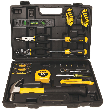If your walls are all the same color, then painting into tight corners does not present much of a problem. But if your walls are different colors, painting a tight corner can be challenging. Follow these steps to achieve clean corners when painting:
Another method for painting into tight corners is to use an artist's brush in the corner, before painting the rest of the wall. Use a quality artist's brush with angled bristles and paint a strip about one-inch wide from the ceiling to the floor. Take short strokes, using plenty of paint per swipe. Since smaller brushes use less paint, you will need at least two coats of paint per wall. Once you've finished the corner strips, paint the rest of the wall.
One more method of painting into tight corners is the paint-and-wipe method. Quickly paint as much paint as you can straight into the corner, without worrying about getting it onto the other wall, and then just as quickly use a very damp rag to wipe the paint away from the facing wall. If you are using any color but dark red, this is a great method for painting tight corners.
I've also found sponge brushes are great for getting paint into places that a regular paintbrush can't reach, like the small bit of wall between two door jambs. Sponge brushes are actually bits of sponge, glued to a wooden handle. Manufactured to be used and then thrown away, sponge brushes are inexpensive and easy to use. Just make sure that you have enough paint in the sponge, since they are highly absorbent.

Find the Right Tool Right Away Finally, a homeowner's set that includes all the tools needed to complete basic DIY projects at an affordable price! The tools are stored in a molded case for security and portability. Check out Stanley 65-Piece Homeowner's Tool Kit today!
When choosing a paintbrush, consider the surface area you will paint, the type of paint you will use, and whether you ...
Discover MorePainting can be a really fun, and simple, home improvement project as long as you know what you are doing. Good thing ...
Discover MoreThere is a definitive difference between someone who is painting a house, and a good painter. Here are some simple guide ...
Discover MoreThere are currently no comments for this tip. (Be the first to leave your comment—just use the simple form above!)
Copyright © 2025 Sharon Parq Associates, Inc.
Comments